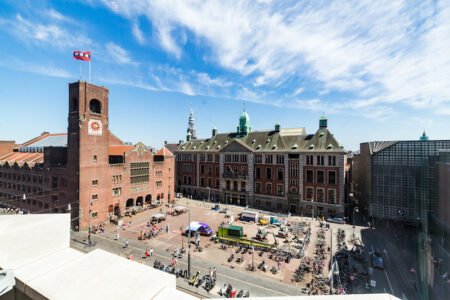Interpack 2023: extended special event review
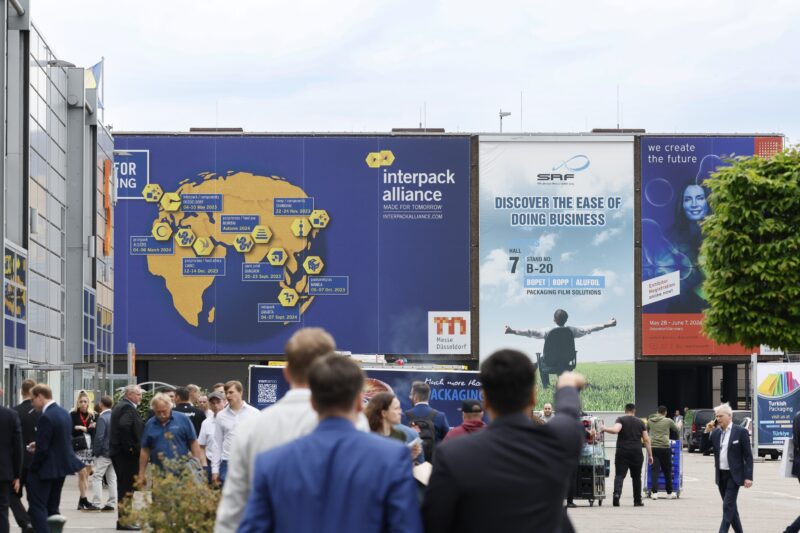
pic: This year's Interpack drew a major global audience. Pic: Interpack
A host of technology, systems and equipment were unveiled across this year’s Interpack event in Germany, as Neill Barston discovers speaking to a number of leading businesses at the much-anticipated show on its long-awaited return.
After an epic delay of six years, Interpack made its mark on Düsseldorf, Germany, in some style, as equipment and systems companies from around the world assembled to deliver and showcase their latest industry innovations (see our exclusive video review of the global showcase here).
There was an especially strong sense of anticipation surrounding the event’s eventual return, which has promised much in terms of new machinery and automation solutions that are set to make a difference to the global market this year.
Despite a number of background challenges including the ongoing energy crisis and rising cost in components and ingredients for finished product ranges, there was a tangible mood of anticipation and excitement across the event’s total of over 17 halls. The last edition attracted a major total of 170,000 visitors across the weeklong industry extravaganza, and hopes remain high from observers that the total gained back in 2017, will be matched with the latest edition of the global event, bringing 2,700 exhibitors.

Organisers of this year’s trade fair have reported being significantly encouraged by its results, in terms of both its strength and depth of participants, who contributed to a highly memorable show. While the final visitor tally of 143,000 may have been less than previously attained, the venue’s management noted that three quarters of those attending were from outside of Germany. Alongside many European countries, the largest visitor nations were India, Japan and the USA.
Around 75 per cent of visitors came from middle or top management. “Interpack 2023 will reverberate with us for a long time – both in business and personal terms,” says director Thomas Dohse (below) after the conclusion of the epic seven trade fair days.

He added: “The mood in the halls was great and the inter-cultural exchange enriching for all sides. It was ‘simply unique’ again,” with a survey finding 96 per cent of visitors had completed their objectives for the show. Proceedings had kicked-off with a major presentation led by Gerhard Schubert’s sales director Marcel Kiessling, and Ralf Schubert, offering their insights into the full spectrum of equipment being offered by the company at the show.
This included its striking Cobot tog.519, which is now ready for series production, and is considered highly flexible and versatile. They also discussed new Box Motion sealing technology for its flowpacker, as well as the compact TLM Power Compact system with Cobots for the natural cosmetics manufacturer Börlind.
There were also a number of other demonstrations such as its TLM Comfort Feeder, Schubert’s solution for handling blanks directly from the pallet, and a showcase for the company’s new “Packaging Perspectives” programme, with which Schubert combines consulting, packaging development and research for more sustainable packaging solutions As the senior figures from the business noted, the fast tog.519 Cobot system, as well as its other innovations had the potential to deliver gamechanging results with delivering automated pick & place tasks in the infeed, as well as enabling greater manufacturing flexibility for packaging and processing operations. According to the business, the integrated systems – from the robot arm through the control system and image processing all the way to the cooling and protective cell – make the cobots entirely autonomous and mobile. They can reportedly be used effectively to close automation gaps at different and ever-changing points along the production process.
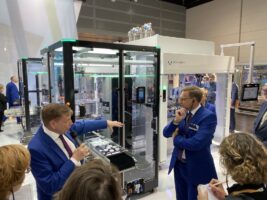
Similarly enthused, Markus Rustler, CEO and president of Theegarten-Pactec revealed to Confectionery Production that the trade fair had gone notably well from its own perspective. “We had an excellent start to the show with a lot of new customers stopping by and showing an interest, so we are more than happy to be back after six years. “Everyone during the pandemic realised that there’s nothing like a live exhibition – we did things digitally during that time, but in the end, being back in Düsseldorf and giving customers the chance to ‘touch the steel’ is indispensable,” said the CEO, who felt there was an encouraging reaction to its systems on the stand, which included a debut for a new secondary cartoning line for display packaging, and its recently-unveiled CHS packaging machinery system.

World record delivery
Among those speaking to Confectionery Production, which reported live from the event, was Wouter Tanis (below), of the Netherlands-based Tanis Confectionery group, who expressed his gratitude at the global show’s return, as well as reflecting on the company’s major achievement in gaining a Guinness world record for the globe’s largest ever gummy sweet.
“We’re really excited to be here at Interpack – where we have seen that partners, customers and prospects are here with a smile, along with ourselves, and we’re really happy with the booth, “The gummy is such a beast that attracts so much attention, everyone is just smiling at it – as it went viral in Holland, and I have been on every talk show going there, and now we see it at the exhibition, which is really good.
“It’s a huge achievement for us – at first, we thought it was going to be easy, as we are specialists in this, but it was harder than we imagined. But we worked with a really big team on this, including working a lot of hours at the weekend, and we’re delighted to have the Guinness World record,” explained Wouter, who added that the initial preparations for Interpack had gone according to plan, and noted that the business will be using the show to highlight its turnkey capabilities.

Meanwhile, Italy’s Cama Packaging reported strong interest in its booth, which included a striking innovative avatar greeting visitors to the stand, which it has dedicated to showcasing a wide range of industry packaging solutions, including for confectionery. Paola Fraschini, marketing manager for the group, explained that having been with the com pany several years, this was her first Interpack, and noted she had been greatly encouraged by the sector response.

“Interpack is a huge and amazing show, and just one of the many events that we have been part of in the past year, and we have also looked to partner with a number of businesses in the sector which has kept us connected to the industry.” As she revealed, among this year’s focuses for the company, has been a smart packaging initiative from six Italian businesses, which has enabled greater collaborative improvements for the region’s industry. “We always look to tell a story about our customers, who provide our range of applications,” explained the marketing manager, who added it had made a major investment in its booth for 2023.
For his part, Michael Corfixen, Somic’s area sales manager for Nordics, noted that its stand had received a significant stream of visitors eager to explore its latest 434 packaging machinery line, which offered key upgrades over previous iterations. As the sector specialist relayed, the enhanced series has applications right across the spectrum, including food and confectionery, which has been instilled with a high degree of focus on delivering a quick format changeover.
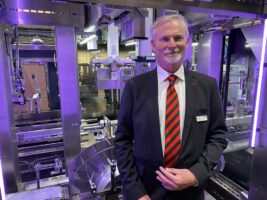
“There’s been a lot of development time put into the new line – while we are working with known principles, it still takes that time and hard work to ensure that it is perfect,” adding that the new series’ ability to deliver four lanes of production by a magnetically-controlled system, ensured greater levels of flexibility for manufacturers.
On that note, one of the most engaging displays of the show came courtesy of Australia’s tna packaging solutions, which offered an augmented reality display based on the concept of ‘Factories of the Future’ offering a VR walk-through of its complete lines, which have notable application for the confectionery sector. Speaking to Confectionery Production, Bindu Panicker, brand and corporate communications manager, revealed the company had been heartened by the reaction to its showcase. She said: “It’s been fantastic, we thought things would be busy from the first day, but the second day continued to be busier, so we’re very excited to have been here and happy with the responses we have had.
Of course, it takes a lot of time to prepare, but it is all about teamwork, and there have been many people working on multiple aspects on it – it is many years in the making, and we are already planning for the next one. “We have always had very good feedback from the show and have been coming here since the early days of the company,” she added of its presence, which included a centrepiece presentation of its flagship Robag vertical form fill and seal line.
Packaging innovations
Regarding packaging systems, US-based Fresh-Lock also discussed its updated series of environmentally-friendly packaging options, which the company noted had gained plenty of interest from visitors. As Todd Meussling, senior manager, market development, explained, there had been encouraging responses at the event. He added: “It’s been a really good start – what has been interesting is how it comes at you in waves, there may not be anything for a little while, then suddenly lots are on the stand. “A lot of the questions they have had for us have been from what we can do for them from a sustainability standpoint. There has also been a lot of discussion about how people are looking to transfer from rigid packaging to flexible options, which by itself brings down companies’ carbon footprint.”

British manufacturing
UK-based equipment group BCH has revealed a strong response to its appearance this past week at Interpack, with the company showcasing a selection of its present machinery portfolio at the event. The Whitworth firm, which has produced a wealth of systems including liquorice production lines, as well as ranges targeting additional fruit cooking and extruded healthier confectionery markets, as well as venturing into manufacturing equipment for CBD jellies and jam for a wide range of sweet treats. As Stuart Grogan, operations director for the Lancashire company revealed, the business gained a positive response from visitors to this year’s show. He said: “The team is thrilled to be back in Düsseldorf after six long years without the one of the worlds flagship shows and have been overwhelmed by the level of interested in our food and confectionery process systems during the show.

“A healthy mix of both new and existing customers have visited our stand and we are looking forward to processing all these enquiries, growing existing and forming new exciting partnerships around the world. In the absence of Interpack, the business had continued with its ongoing development of ensuring we deliver the most energy efficient, hygienic and product specification meeting equipment to conform with these constant growing trends and expectations in our market.”
In addition, he added that the past twelve months have been extremely busy, as well as offering key challenges as the business continues to grapple with shortages in the electronics supply chain. But in spite of this, the business explained that its strategies have ensured that we have been able to deliver all its projects to a successful conclusion and with minimum disruption.
Wymbs, the UK-based equipment and systems group, reported a markedly upbeat response to its exhibiting appearance. Located in Stockport near Manchester, the business has spent decades producing pressurised manifold depositors for aerated chocolate products, as well as working with leading biscuit and wider confectionery manufacturers in delivering bespoke solutions for the sector. Director Kevin Wymbs, believed that the return to the event was proving fruitful for the business, which has continued to export its depositing systems around the world.
Speaking to Confectionery Production, he said: “It’s great to be back on show again and in our usual place in Hall four. “We have met lots of new customers and you can feel the upbeat approach to meetings. It was good to feel the “we are all in it together” feeling between suppliers as well, with sharing supplier contacts and pointing customers in certain directions. Always a proud point for us is when we realise how popular such a small company like Wymbs is in our field.”
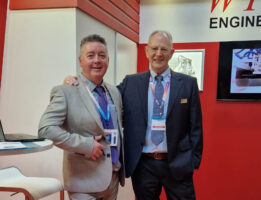
For his part, Joe Gorman, managing director of MacIntyre Chocolate Systems, based in Scotland, enthused that the event had been highly productive for the business. As he noted, the firm, together with its affiliated company, Bauermeister and parent business, Probat, scored a combined success across the week-long sector showcase.
Joe said: “Having been so long since the world of process and packaging came to Düsseldorf, visitors from around the globe have been eager to find out what’s new. “The group has received huge interest in their AI solutions now available. With ever increasing energy and operating costs, unnecessary over processing is unacceptable in today’s climate. “Bauermeister (the milling specialists) have also received a lot of interest with a number of companies seeking their recommendation for intricate process applications. In addition, he added that the enhanced design of its Next Generation range of Refiner/Conches, from MacIntyre Chocolate Systems, has surprised visitors with many companies who were not aware of the shorter cycle times, lower energy consumption and minimal maintenance.” Furthermore, he reflected that many companies did not appreciate this technology could be used for highest quality chocolates, compounds, cremes, spreads, nut/seed pastes and also for rework, which offered a rewarding task to its sales teams across a memorable week.

Starchless depositing
Another British-based firm reporting an encouraging performance at this year’s showcase was Peterborough’s Baker Perkins, which had invested significantly in a prominent stand this year, presenting systems targeting the burgeoning market of functional, nutraceutical and healthcare-linked confectionery.
This included two advanced starch-free depositors which are an extension of the ServoForm range which extends from small batch and laboratory scale equipment to fully automated high-output continuous lines. As the company noted, its 50kg/hour ServoForm Mini+ depositor meets increasing demand for high-viscosity recipes and gummies with liquid centre fillings; while the ServoForm Flexi offers higher outputs from 100 to 1000 kg/hour. Both depositors can be incorporated into completely automated lines, from ingredient handling to finished product, as well as being utilised in the conventional confectionery industry.
Keith Graham enthused: “The show has gone very well. There was always a concern that after covid, the numbers would come back again, but it does appear that people do still want to travel to see and touch equipment, and meet people face-to-face.
“I think one of things about this show is that it doesn’t change dramatically. It does evolve over time though, but there’s a degree of familiarity about it, which helps. We’re in the new hall 1 now, which is really good compared to the old one which was getting a little gloomy. It’s obvious that the industry is in good health, with lots of people visiting from around the world. It’s the kind of event that you just can’t replicate online. It’s memorable – as people buy people, and this is one of those places that brings them together.
“We’re still in the hard candy and lollipop business with our lines, there’s still demand out there, but the real growth area is within gummies and jellies, and also in parallel to that is the nutraceutical gummy, which are different customer bases,” explained Keith, who revealed that the nutraceutical end of the market had seen momentum from start-up companies looking to make their mark on the industry, as well as contract manufacturers. He concluded that there had been significant interest in its Flexi series of depositors, which enabled fast changeovers between manufacturing runs, as well as benefitting from starch-free processing.

Chocolate processing success
Among the major chocolate processing groups exhibiting, Ralf Schaffer, executive director of Sollich (below), believed that the company had enjoyed an especially positive response to the event as it made its return. He said: “It’s been very good. We’ve met a lot of existing customers who have been really keen to see us again, as well as the equipment, so all my colleagues have been very busy, so we’re really happy. We have some new areas that we are moving into, including Sweet Connect (digitally linking companies with a data sharing programme), which is trying to bring together the whole sweets industry. Some people are hesitating over, while others think it’s wonderful – which I think is partly to do with mindsets, and also a generational thing, but it’s really interesting.
“In recent times, like others, we have suffered in regards to electronic components. As manufacturers, there are many things that we are actually producing ourselves, that enable us to carry out a lot of the cutting and forming work, making us independent from sub-suppliers – but on the electrical items, it has been a little difficult. But we have somehow managed – we are quite flexible and our customers have been very understanding. They have been very much supporting us in terms of time scales of projects,” added Schaffer, who explained that the business has proved resilient amid market challenges.

As he noted, the business had intended to celebrate its centenary at the last Interpack (which it would have celebrated with its sister business Chocotech (also marking its century in 2020), yet the show’s cancellation due to Covid-19 set back its plans – which led to the business showcasing some of its heritage for the 2023 edition of the show, including an image gallery wall of prominent figures and events in its history, including a portrait of the company’s founder.

Moreover, for his part, Dr Michael Grosse, CEO of Syntegon, led a media launch of the company’s expansive stand at this year’s show, which saw the business unveil what it has hailed as ‘a landmark innovation’ for high-speed vertical bagging in presenting its new SVX vertical form, fill and seal series, presented in two formats at the event.
The new VFFS machine series combines high pack style flexibility with intuitive functionalities, giving frozen food, bakery, confectionery, and snacks producers a leg up on competition,” says Martin Boutkan, product manager for the business. “Thanks to a wealth of easy upgrade options and access to our digital services, the SVX series helps customers keep up with market trends while running stable processes at all times.” State-of-the-art monitoring via the cloudbased solution Synexio allows to optimise production, while Syntegon’s value-packed Service Agreements ensure maximum uptime and performance, including maintenance, parts management, and tailored training packages.
The company presented two SVX variants, which will be launched this year along two other SVX models: during live demonstrations, visitors can experience the new technology first hand. The SVX Agile is said to form the basis for all single tube applications. As the manufacturer explained, the machine covers all basic tubular bag styles and can be upgraded with modules for corner sealed bags, three-sided seal bags, doy-style, and doy zip bags. In contrast, the SVX Duplex features two film lanes on the same 1,220 mm wide frame, leading to higher output rates for basic bag styles such as pillow, gusseted and block bottom bags.

Speaking at the company’s briefing, Dr Grosse (above) said: “Through our 5,800 employees we are living up to our mission of processing and packaging for a better life ever day. Under that banner we’re providing individual machines for specialised industry applications through to fully automated lines within food and pharma, all the way to digital services in order to improve peoples’ lives, whether that’s through processing a vital drug, or if it’s a cookie or chocolate.
“From 2020 when we started under the Syntegon brand, we were able to drive growth from 1.2 billion, to 1.44 billion, and 2022 had been a tough year in many respects. We witnessed the war in Ukraine, and an unprecedented level of supply chain disruption and unavailability of parts, as well as the highest level of inflation seen across the globe, and an energy crisis in between, off the back of the pandemic. Under those circumstances, we were really proud to say we were able to weather these challenges and still deliver growth,” explained the CEO, who noted that around a third of its growth was attributed to spare parts and field services, with the remainder due to the development of new equipment lines.
“We realised that it’s important to address collective challenges that we are all facing, and we take responsibility for this. We have set a very clear goal, ambitions and targets that are measurable are part of our environmental and social and governance. I would like to highlight our progress on the environment – It’s important that you clean up your own house, before looking to others, and focused a lot on our own carbon emissions and set a target of reducing 25% emissions between the years of 2019-2025,” he added, noting that it had followed the lead of the Science Based Targets initiative in devising its approach to improving the sustainability and efficiency of its manufacturing operations.
He noted that company transparency, and a willingness to share that progress with others in the wider industry was also of significant importance in terms of delivering on overall business strategies that are truly sustainable.
Flow wrapping systems
As regards other notable breakthroughs, Confectionery Production spoke to Christoph Krombholz regarding its latest flow wrap packaging system that gained pride of place among a broad display of machinery on its stand this year.
Its latest innovation centred on delivering a modular system focused on a hygienic design, simple operation, and a small footprint, with its machines equipped with a new “easyMI” HMI (Human- Machine Interface) with an 18.5-inch touchscreen. Speaking to Confectionery Production the company explained that the business had experienced a notable demand for its equipment during the Dusseldorf event.
“It’s felt very very good to be back again here. It looks like it has restarted really well, with many people having visited us, so it’s been very good for us. We’ve had new equipment to show existing and potential customers, which is a good thing,” explained the packaging specialist, who conceded that this year’s show represented a learning curve for many in the industry, especially those who have joined the sector in the wake of the last event held in 2017, explained Christoph.
He added: “Since the last Interpack, we have taken the time to redesign two of our machines – we have a new top loading cartoning platform, and also have a completely redesigned flow packing machine which is the fastest we have ever displayed. We can produce with it here at the show up to 1,000 chocolate bars a minute as live demonstrations which has been good, and people have really liked it, he added, explaining that the business had engaged with people from around the world, from the US to Asia, noting that the event had definitely lived up to its international branding across industries, with chocolate and gum remaining its two biggest areas of focus. He observed that while there had been notable supply chain issues regarding the supply of specific electronic parts, he believed that the situation was improving moving into the summer months of 2023.

Chocolate wrapping systems
Commenting on the show, Andrea Boggio, CEO of Sacmi Packaging and Chocolate (pictured below), appeared confident regarding the company’s performance in Germany. From exploring its extensive stand at the Düsseldorf trade fair, the business had focused on delivering a dynamic series of equipment across the sector, including for confectionery. The CEO said: “We are very satisfied, both in terms of quantity and quality of participation.
The visitors who crowded our booth on all trade fair days showed great interest in the many technological innovations within our offering. “The innovations in the field of wrapping have gained particular interest, among others.
With the new HTB for wrapping chocolate tablets, we are moving from a purely mechanical design approach to an electronic architecture that minimises consumption and guarantees the best quality wrapping at very high speeds. It is a unique solution on the market which, among other things, opens up the possibility of using eco-friendly materials, allowing the best flexibility and efficiency to manage different materials.” As he added, chocolate processing and moulding lines remain at the heart of the Italian company, with more than a century of heritage behind its equipment development
“Today, the main challenge in this field consists of designing highly versatile solutions that guarantee at the same time the highest production and quality performances typical of traditional lines. The new Nano Chocoline by Sacmi Packaging & Chocolate goes exactly in this direction. Furthermore, here at Interpack we presented the Cavemil Super 860 moulding line, the latest evolution of the Cavemil series, a true icon of our company around the world for over 70 years.”

Bakery and snacks developments
On the bakery side of the industry, the UK’s Sugden, devising waffle making machinery for the bakery market, also experienced a positive week in Germany, with the company reporting numerous enquiries regarding its lines. Chris Baldwin, managing director for the business welcomed its results. He said: “It has been really good, very positive and strong enquiries every day from it, which we have been really pleased by. This is my first time here – it has been busy from the start to the end of the show.
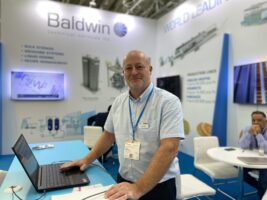
“There’s been strong interest in our Stroop waffle lines from all over the world, and have proved very popular. It’s been a challenge period for us in recent times, but things are now starting to pick up with some really good orders from overseas. So I think we are now in a strong position going forward, with orders coming in for 2024/2025, so hopefully the hard times are over for us now, and we can look forward to the future.”
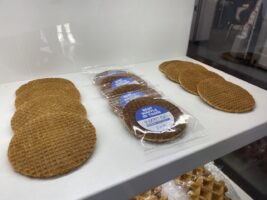
Meanwhile, Sylvie Evers (below), of equipment group Extrufood also shared a positive outlook on the show. She said: “It’s worked well for us here and we have a really positive vibe about the show,” noting that there was a marked balance of both new and potential customers that had been particularly encouraging.
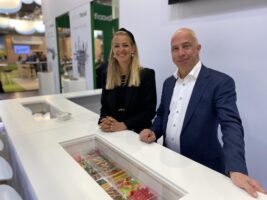
Olaf Schepel of Caotech revealed to Confectionery Production that the event had been “very good’ in terms of visitor response and the quality of potential leads received during the week-long event had made it worthwhile exhibiting after such a long break.
He said: “We were surprised on the first morning that so many people passed by to see us, as there was some hesitation from everyone here as to what would happen with it all, whether there would be enough people, but has been good, and have seen interest in cocoa machinery, compound and chocolate production too, particularly seeing some good interest from central and south America.
Reflecting on the past couple of years, he said that the pandemic had posed challenges during that period “as people are social beings and can’t be locked up” noting that the restrictions on personal freedoms impacted on all aspects of everyones lives. However, he was relieved that the concerns of covid appear to have receded now and that the popularity of Interpack has been particularly inspiring.

Meanwhile, Mike Coray of Swiss equipment and solutions business, Buhler, also felt the week had gone especially well. He commented: “It was such a positive surprise to see so many people networking with us and seeing our solutions. It was great for our teams there including those responsible for confectionery to be able to show customers what equipment like our ChocoX can do, meeting a lot of decision makers within the industry. ChocoX was launched a year ago, but it was nice to have it on the show, as we actually have proof of concept now as we have one that has already been installed with a customer, which provides a basis for discussions.
He added that there had been a real buzz on its stand, with augmented reality forming a big focus for the business, as well as customers responding positively to its ‘food sensations’ displays that were designed to offer plenty of inspiration for product development and future ideas for the sector.
“I think our food sensations was a big reason for the vibrancy of the stand, where people could come and try products that they had produced or wanted to produce, or even something they hadn’t even thought of that they can try and eat, so it’s that chance to taste and experience something which was important. We have been very satisfied with how the show has gone,” he explained, noting that customers had been particularly drawn to both the series of sweets on display within its booth, as well as other product areas such as protein-based ranges.
Automation creations
Regarding software solutions present in Dusseldorf, Roger Gaemperle, of Rockwell Automation explained that the company had been actively developing a wide spread of software solutions that are applicable across the food and drink sector, including for confectionery markets. Among its offers were digital twin software on display, as well as specific solutions designed to enhance maintenance and service schedules for many machinery segments.
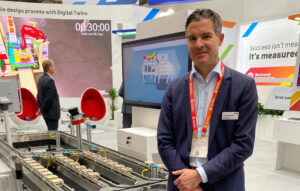
“It was great to be back here after so many years and to meet partners and also customers, and what we hear from our OEM partners is that it also went very well they had great feedback from many visitors, and the same was the case for us. It’s great to connect internally, but to see all the innovations was a really great week.
“What we showed for our booth we had solutions for designing and operating machines, as well as maintaining machines – we have a number of solutions at Interpack – such a the digital twin software which included virtual reality demonstrations,” noted the expert, explaining that the company also offered augmented reality solutions for maintenance of equipment, which has become an increasingly significant factor in recent years.
Furthermore, he highlighted a key partnership with Kezzler AS, which is a cloud-based product digitisation and traceability platform, to help manufacturers capture the journey of their products from raw material sources to point-of-sale or beyond using cloud-based supply chain solutions that focus on product traceability. He noted that this had specific potential use within market segments such as food and beverage, and consumer packaged goods focused on regulatory requirements and consumer standards on product quality, safety and sustainability – citing use of such systems within cocoa supply chains to track the full production chain.
“I saw many interesting solutions at this year’s show – compared to a decade ago a lot of the machines were built in a closed aluminium, you can see inside them, using plexiglass, to save on weight, which is perhaps a cost saving.
“Since the last Interpack, in general, digital tools have become more and more adopted. Firstly, adopting was low, but now it’s accelerated. If you look at the past year or so, the main driver in the market is sustainability – the huge cost increases in energy and raw materials due to the war in Ukraine has, and labour shortages, have had an impact of which in solutions are being sought after or developed, and technology can help in those areas.”
Overall, the wealth, diversity and depth of technology, systems and machinery for the sector on show across the week offered a major window into the direction of travel for the industry. The pandemic has clearly accelerated the drive towards ever-greater levels of equipment automation levels to satisfy continued growth within international machinery markets, which was smartly showcased at Interpack.

